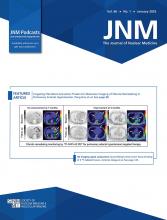Visual Abstract
Abstract
In animal studies it has been observed that the inhibitory neuromodulator adenosine is released into the cerebral interstitial space during hypoxic challenges. Adenosine’s actions on the A1 adenosine receptor (A1AR) protect the brain from oxygen deprivation and overexertion through adjustments in cerebral blood flow, metabolism, and electric activity. Methods: Using 8-cyclopentyl-3-(3-[18F]fluoropropyl)-1-propylxanthine ([18F]CPFPX), a PET tracer for the A1AR, we tested the hypothesis that hypoxia-induced adenosine release reduces A1AR availability in the human brain. Furthermore, we investigated whether this response is associated with altered brain perfusion and psychomotor vigilance. Ten healthy volunteers completed a 110-min bolus–plus–constant-infusion [18F]CPFPX PET/MRI hybrid experiment including a 30-min interval of normobaric hypoxia with peripheral oxygen saturation between 70% and 75%. We obtained blood samples to calculate metabolite-corrected steady-state A1AR distribution volumes and measured gray matter brain perfusion via arterial spin labeling in high temporal resolution. A 3-min psychomotor vigilance test was conducted every 10 min, and heart rate and peripheral blood oxygen saturation were continuously measured. Results: In all 7 examined brain regions, hypoxia reduced A1AR availability significantly (e.g., frontal lobe, 13.5%; P = 0.0144) whereas gray matter brain perfusion increased (e.g., frontal lobe, 42.5%; P = 0.0007). Heart rate increased by 19% (P = 0.0039). Mean reaction speed decreased by 4.3% (P = 0.0021). Conclusion: Our study is the first, to our knowledge, to demonstrate that acute hypoxia, corresponding to a mean altitude of 5,500 m (18,000 ft), reduces A1AR availability in the human brain. The finding is consistent with hypoxia-induced cerebral adenosine release leading to increased A1AR occupancy.
Footnotes
Published online Dec. 12, 2024.
- © 2025 by the Society of Nuclear Medicine and Molecular Imaging.
This article requires a subscription to view the full text. If you have a subscription you may use the login form below to view the article. Access to this article can also be purchased.
SNMMI members
Login to the site using your SNMMI member credentials
Individuals
Login as an individual user








